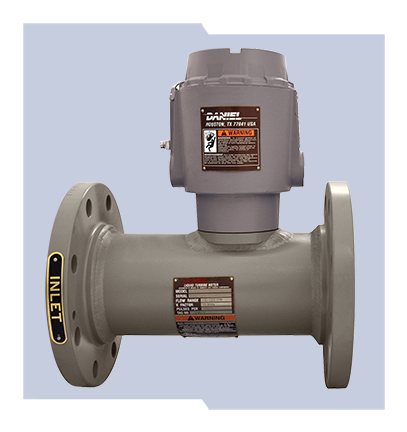
About the Daniel Series 1200 Liquid Turbine Meters
Durability For Sustained Performance
Daniel Series 1200 Liquid Turbine Meters are relied upon by load rack and marketing terminal operators worldwide for their accurate, repeatable performance during fiscal measurement or inline blending operations. The meters are low maintenance and feature a self-cleaning, flow-through bearing design that enables higher flow rates plus an extended flow range on light hydrocarbons and light crude products. Meter performance is improved with the inclusion of highly durable potted electronics that provide the outstanding combination of a new dual-channel preamplifier plus one or two pickoff coils. With the optional second pickoff coil, total pulse integrity is guaranteed, and the possibility of missing or double-counted pulses is virtually eliminated, further improving measurement accuracy.
Specifications of the Daniel Series 1200 Liquid Turbine Meters
| Line Sizes | DN25 to DN100 (1-in to 4-in) |
| Fluid Type | Liquid |
| Linearity (standard) | 1-in to 2-in: 0.25%; 3-in to 4-in: 0.15% |
| Repeatability | ±0.02% |
| Process Temperature Range (standard) | Carbon Steel, ASTM A352 GR LCC |
| Materials: Valve Cylinder | • Carbon Steel: -29 C to +60 C (-20 F to +140 F) • Stainless Steel: -40 C to +60 C (-40 F to +140 F) |
| Operating Pressure Range | PN20 to PN50 (ANSI 150 to 300) |
| Materials | Carbon steel and stainless steel |
| Electronics | 1 or 2 pickoff coils and Dual-Channel Preamplifier (standard) |
Features of the Daniel Series 1200 Liquid Turbine Meters
- Fiscal measurement accuracy is improved with a pulse output linear with flow rate and 10:1 rangeability (turndown).
- High-frequency pulse resolution maximizes accountability and enables the measurement of minute increments.
- High-performance stainless steel internal assembly ensures maximum volume throughput and minimum pressure drop.
- An optional second pickoff coil ensures total pulse integrity, eliminating missing or double-counted pulses.
- The new threaded lid simplifies maintenance by allowing easy access to the preamplifier and pickoff coil(s).
- UMB-equipped meters can be easily upgraded to the new LME housing featuring potted electronics to improve durability.
- Reliable stainless steel or tungsten journal carbide bearings improve durability and minimize maintenance.
- The meter can be used with confidence within the guidelines of API MPMS, Chapter 4 (proving) and Chapter 5.3 (measurement).
Turbine Meter Theory by Daniel Series
The design of Daniel liquid turbine meters is based on a simple theory. When fluid flows through the meter, the turbine blades rotate around an axis which is located along the centre line of the turbine housing. Because the angular or rotational velocity of the turbine rotor is directly proportional to the fluid velocity through the turbine, the turbine meter is an ideal device for measuring flow rate. An electrical pickoff mounted on the body of the meter picks up the meter’s output, with the pickoff’s output frequency being proportional to the flow rate. Each electrical pulse is also proportional to a small increase in flow volume, giving this turbine meter a major advantage in addition to its excellent rangeability. Because this incremental output is in digital form, it can be added up to be a total, with a maximum error of one pulse regardless of the volume measured.
The basis of any liquid measuring system comprises the turbine meter and associated digital electronics. The turbine rotor is held in alignment with the fluid flow by an expanding blade hanger assembly. The angular velocity and the output frequency of the meter are governed by the angle of the turbine blades to the stream. When there is a sharper blade angle, a higher frequency output will be provided. A blade angle between 20º and 40º to the flow is generally used. This is because lower angles cause an angular velocity that is too low and repeatability is lost. Larger angles cause excessive end thrust.
Download more resources (documents and drawings) here.